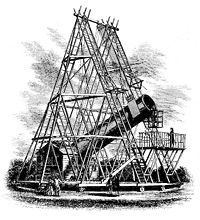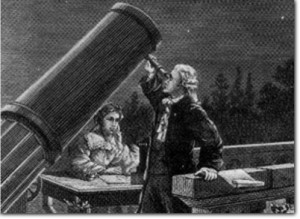created: 01-25-2013.
revised: 02-05-2021
After the Messier List, the Herschel's are the next most observed deep-sky objects.
Most amateur astronomers know them by their
NGC or IC numbers, but they started out as a list created by British astronomer William Herschel and his sister Caroline.

From 1782 to 1790, the Herschel's conducted systematic surveys of the night sky, in search of "deep sky" objects, and discovered over 2400.
William's son John later added another 1700+ entries to the list.
Eventually, all of the Herschel objects, along with discoveries from other astronomers were combined and published in 1888 as the New General Catalogue (abbreviated NGC).
In addition to his deep-sky surveys, William Herschel also discovered the planet Uranus and two of it's moons - Titania and Oberon, along with Saturn's moons Mimas and Enceladus.
He also discovered over 800 double & multiple stars.
Caroline discovered 8 comets and was honoured by the Royal Astronomical Society.

Herschel classified his list into eight sub-categories:
Class I - Bright Nebulae;
Class II - Faint Nebulae;
Class III - Very Faint Nebulae;
Class IV - Planetary Nebulae;
Class V - Very Large Nebulae;
Class VI - Very Compressed and Rich Clusters of Stars;
Class VII - Compressed Clusters of Small and Large Stars;
Class VIII - Coarsely Scattered Clusters of Stars.
Herschel 400 map
Distribution of Herschel 400 objects, Red = Galaxies, Green = Nebulae, Yellow = Star Clusters
The Herschels and their Catalog! PDF
Caroline discovered 10 new deep-sky objects (1 galaxy and 9 starclusters).
Caroline kept track of her deep-sky discoveries with the intention of creating her own catalog, eventually recording entries for 21 different objects. But five of the objects observed by Caroline had been previously discovered a few years prior by Charles Messier (M29, M46, M48, M93, & M110) and two by Philippe de Cheseaux (NGC6633 & IC4665), all of which Caroline had been unaware of due to their either being unpublished, reported with positional errors, or miss-identified by Caroline. Additionally, two objects were never able to be reconfirmed and are considered lost, and one object was a duplicate.
All of the identifiable objects on Caroline’s unpublished catalog can be observed with a small 80mm refractor or 4.25” reflector rich-field telescopes using low powers.
Caroline's Catalog! PDF
For more info on Caroline's List, see:
https://skyandtelescope.org/observing/in-caroline-herschels-footsteps/
https://skyandtelescope.org/astronomy-news/explore-caroline-herschels-celestial-showpieces/
http://www.messier.seds.org/xtra/similar/cher.html Michael Hoskin's recent work on Caroline Herschel's astronomical observations
The idea for this 'Herschel Tour' project started back at the end of 2012, as I was wrapping up my 'Constellation Tour' survey based on the "Night Sky Observers Handbook".
I realized that my survey observations would already include a large number of the Herschel-400 objects.
So after identifying all the '400' objects that I had already observed over the years, it only took me an additional six months
to finish the 'Herschel 400' list on 6/4/2013, by video capturing the final few stragglers in Ursa Major.
I utilized the Astronomical League's "Herschel 400 by Constellation" list and their "Observe the Herschel Objects" booklet.
I then downloaded the AL's "Herschel-II" list of the next 400 objects and began hunting the objects that I hadn't already observed.
By the fall of 2016, I was down to the last 60 objects and was wondering what my next project should be.
Flipping thru some old Sky&Telescope magazines, I ran across an article from the August 2012 issue by Rod Mollise on observing the entire Herschel Catalog of 2500 objects using a video cam.
This was the inspiration (and project), that I needed, so I began a multi-year project to observe the entire Herschel Catalog.
While during the process of William and Caroline Herschel's original recording and publishing of their observations from 1786 thru 1802,
along with subsequent reprints and revisions over the 19th century, there have been a number of discrepancies over misidentified or non-existent objects.
Depending on the source, of the Herschel's 2500 objects cataloged, there are anywhere from the low 2400's to over 2500 actual objects.
Mark Bratton, in his book "The Complete Guide to the Herschel Objects", gives a good review of the issues and historical attempts to rectify Herschel's list of objects.
He eventually settles on there being only 2,435 identifiable Herschel Objects.
(I utilize his book's visual descriptions and DSS images to help in comparing and confirming my personal observations).
In addition to the above book, I also utilized George Kepple's "Night Sky Observers Guide Handbook" and internet resources 'WIKISKY' and 'The NGC/IC Project' to validate my observations.
To help tackle this project, I downloaded several lists from various websites, and after combining, distilling, and sorting,
I generated a personal spreadsheet/logbook to help in my tracking & logging.
The core data for my logbook comes from a list of 2,482 Herschel Objects by Steve Gottlieb.
If anyone is interested in using this logbook, I saved it as a PDF and you can find it on my 'Download' page.
Just be aware that I've found a few 'errors' that I've introduced in my cutting and pasting of various data.
As of May 13th, 2020, I have either video captured or sketched all 2,482 of the Herschel Objects. (from my logbook list of 2,482)
All Herschel Object observations can be found in their individual constellations under my 'Constellation Tour' page.
This page initially defaults the left side index to the 'Herschel 400' list. Click the "GoTo Herschel 2500" to see the entire list.
To return to just the 'Herschel 400' list. Click the "GoTo Herschel 400" link.
Over the course of this project, I have spent a total of 239 nights working my way thru observing all of the Herschel Objects.
Even though I really didn't get serious about completing the list until 2012, my observations stretch all the way back to 1984.
All of the early observations are all visual sketches, (78 objects), with everything after 2001 being video-capture.
I eventually used a total of nine different telescopes for this project, six visually - 80mm f3.2 refractor, 8" f4.5 dob, 10" f5.6 dob, 13.1" f4.5 dob, and a 8" & 12" SCT at f10.
For the videoastronomy observations, I used four telescopes - 50mm f3 refractor, 80mm f6 refractor, 6" RC at f9, f6.3 & f5, and a 8" SCT at f3.3, f6.3, & f10.
The cameras used were a StellaCam-EX (2.5 seconds exposure), StellaCam-II (up to 8 seconds exp), StellaCam-3 (unlimited exp), a Samsung SDC435 (up to 8 seconds exp),
and finally a ZWO ASI294MC Pro camera used in EAA mode (generally for around 120 second exp).
In retrospect, I have learned a lot about the lives of William and Caroline Herschel, along with the objects that they discovered.
While there are a number of nice large, bright objects including galaxies, star clusters, and nebula,
the majority of Herschel's objects are small, dim, nondescript smudges.
It gives you an appreciation for the brighter Messier Objects.
Still, there is a wide variety of interesting deep sky objects for any sized telescope.
I now have a much greater appreciation for all those faint fuzzies and the work of the Herschel's!
Having spent time over the past several years following in the Herschel’s tracks,
you could begin to pick-up on how they were doing their observing run for that particular night back in the 1780’s,
slowly letting the Earth’s rotation bring each object into their sweep.
Using today’s modern equipment, there’s no need to wait;
all you had to do was hop down the sweep path to the next observable object.
When you think about that, it’s sorta inspiring to think that in your own way you are following in their footsteps!
Hope you enjoyed the visit. Come again soon!
Larry McHenry, Pittsburgh, PA. USA
Astronomical Webportal:


